20th Century Cafe’s Sacher Torte
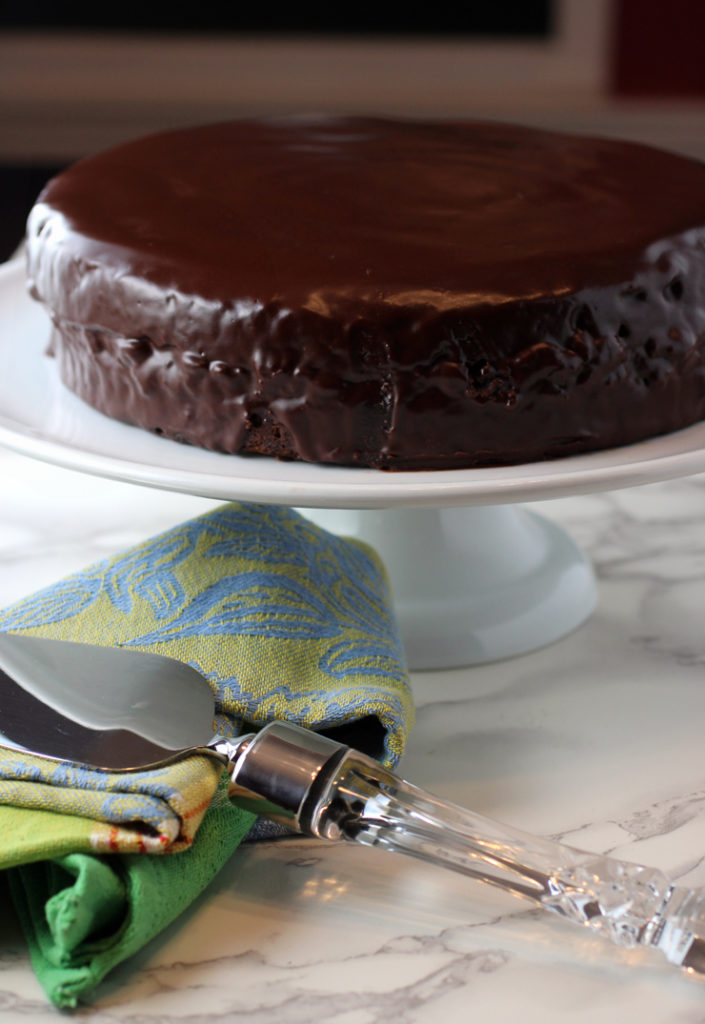
My introduction to this magnificent chocolate creation known as Sacher torte came not in Vienna, where it originated, but if memory serves me, in San Francisco — at Alice Medrich’s legendary Cocolat bakery.
Sitting down to a dark, dense, chocolately slice with a glass in which equally dark filtered coffee was slowly dripping into it was the epitome of elegant adulthood. I almost felt as if I had to hold my pinkies aloft to enjoy each and every bite.
One of the most famed European cakes around, it was first created in 1832 by 16-year-old Franz Sacher, then later gained an outsized following at the Hotel Sacher, established by his son Eduard.
It looks so fancy. And it tastes so fancy. But at its heart, it’s really just a double-layer chocolate cake that’s covered entirely in a dark chocolate glaze and hiding a filling of apricot preserves.
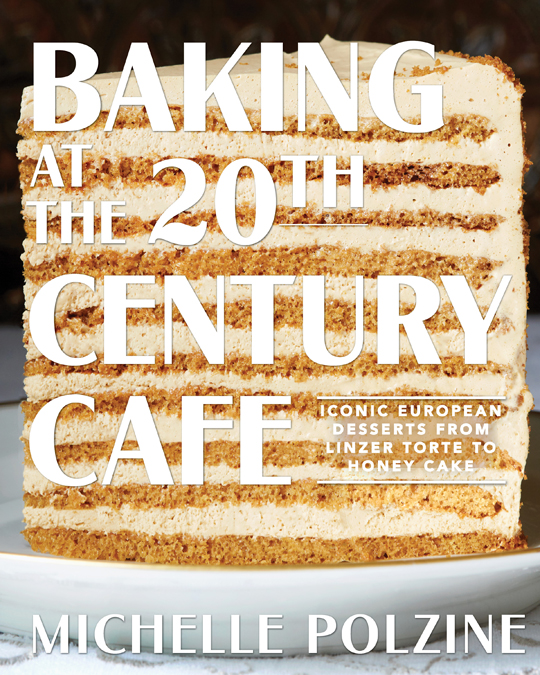
So, if you can make a chocolate cake, you can definitely make a Sacher Torte. Especially if using the recipe from Baking at the 20th Century Cafe: Iconic European Desserts from Linzer Torte to Honey Cake (Artisan Books) by pastry chef extraordinaire Michelle Polzine with food writer Jessica Battilana.
Polzine’s 20th Century Cafe is another one of those establishments that San Francisco is so fortunate to have. Unlike the city’s other bakeries that hew heavily to French pastries, 20th Century Cafe brings to life the taste of Eastern Europe, especially of Vienna and Prague.
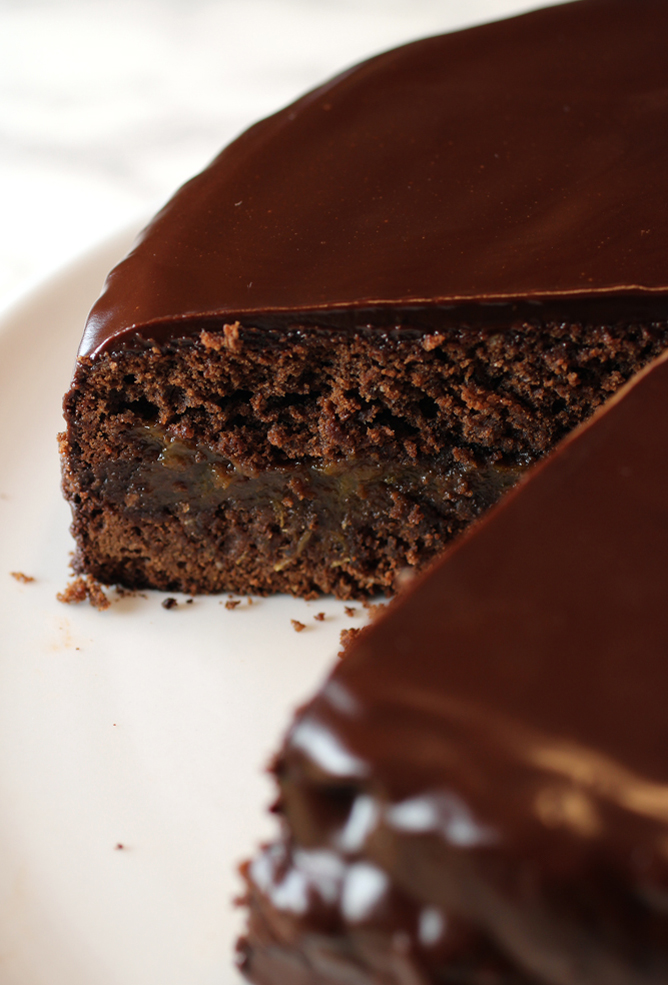
I won’t lie — quite a few of the recipes in this cookbook will take some doing, such as the strudel, which will require stretching the dough so thinly as to cover an entire dining table. There are 22 photos alone of Polzine demonstrating how the small square of dough gets stretched thinner and thinner with her hands and the use of a sheet or tablecloth.
Or the “Dobos Torta,” a glam cake from the Austro-Hungarian Empire, which is seven layers of tender cake and chocolate buttercream crowned with a flourish of caramel-covered cake triangles.
Or course, Polzine’s signature creation is included here: the Honey Cake, in which you’ll bake 10 rounds of cake, then make burnt honey to mix into dulce de leche and heavy cream for the frosting. It’s a nearly all-day affair, if you’re up to it.
If not, there are simpler recipes such as “Apricot-Cherry Cobbler,” “Meyer Lemon Pudding Cake,” “Caraway Seed Shortbread” and “Buckwheat Blini.”
Or try your hand at the “Sacher Torte.” Chock-full of chocolate, it’s just what you want on Valentine’s Day.
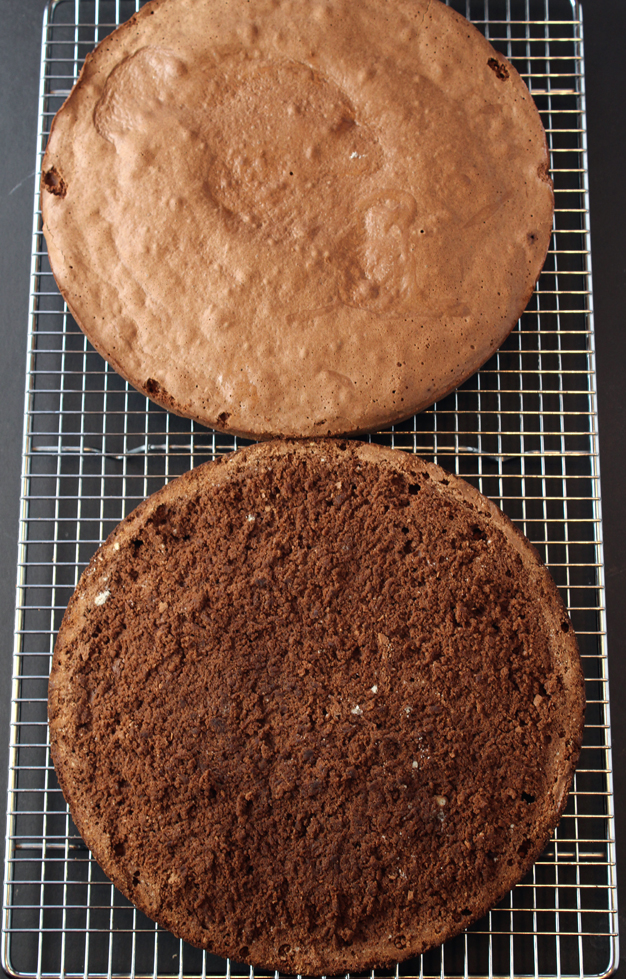
Be sure to read the recipe carefully before you start, as you’ll note that the ingredients list — rather than the recipe directions — state that you’ll need warm chocolate melted in a double-boiler handy as you begin making the cake batter.
Because the cake layers are very dark, Polzine uses a unique technique to determine if they are fully baked and ready to come out of the oven. She holds the pans close to her ear to listen: If she hears the sound of bubbles popping in the batter, she returns the pans to the oven, as that’s a clue the cakes are not quite done yet. I admit I had trouble hearing anything when I attempted this, and I even turned off my hood fan to try to listen carefully. But I think my cakes were done at the 45-minute mark anyway, because when I tried inserting a skewer, nothing stuck to it.
When the layers are cool, carefully slice off their crispy tops, then crumble these trimmings and mix with chocolate glaze to form a paste. Slather the apricot glaze on one layer, then stack the other layer on top, before smooshing this cake paste into the gap between the layers to fill in the space. OK, maybe mine didn’t result in the smoothest spackling job. But hey, it was my first attempt.
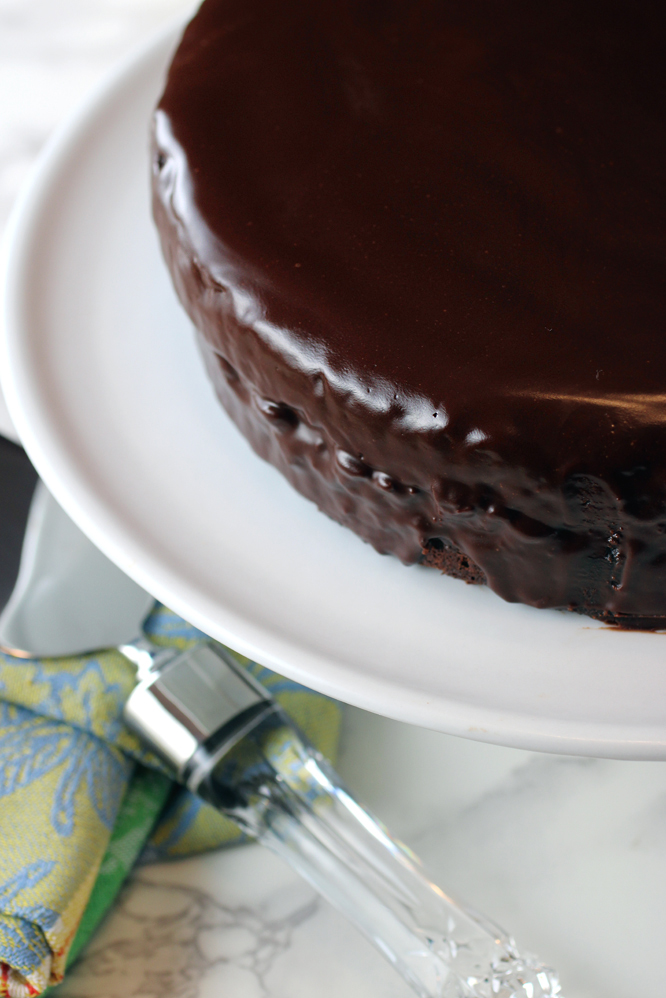
Lastly, liberally pour over the chocolate glaze, which will cover the cake in a smooth , glossy finish.
Scrape up the glaze that’s dripped off and save it to pour over ice cream to create your own magic shell. Or if you have leftover cake-trimming paste, you can form it into balls and dunk into the glaze to form cute little cake balls.
After the cake is refrigerated, the glaze hardens considerably. That’s why I added the direction to let the cake come to room temperature before enjoying. You’ll not only find the cake easier to cut that way, but more enjoyable to eat as the chill will have dissipated, allowing the flavors to really come to the forefront.
Polzine says serving slices of the Sacher Torte with dollops of whipped cream is optional. But I think it’s nearly mandatory; this is one incredibly rich cake, and the whipped cream adds a lightness to counteract that a bit.
The crumb is moist, and the apricot jam — while hard to see once you cut the cake — adds a lovely fruity tang to offset all that decadent chocolate.
This torte tastes of history, culture, and pure extravagance.
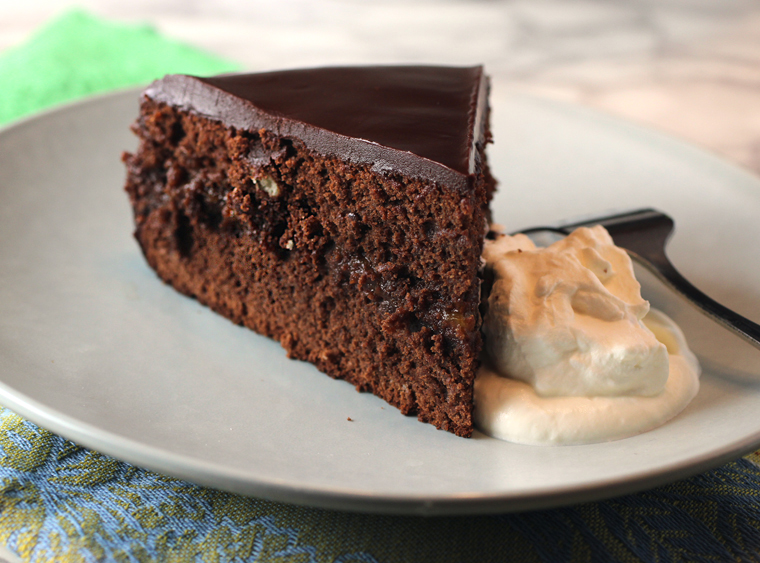
Sacher Torte
(Makes one 9-inch cake; serves 8 to 10)
For the cake:
2 1/2 cups (225 grams) almond meal
1/4 cup plus 1/4 teaspoon (30 grams) Dutch-process cocoa powder, such as Valrhona
1/4 cup tapioca flour
8 large eggs
1 1/2 cups plus 2 tablespoons (324 grams) sugar
3/4 teaspoon kosher salt
6.4 ounces (183 grams) 72 percent cacao chocolate, such as Valrhona Araguani, chopped and melted over a bain-marie in a large bowl and kept warm enough to stay melted
1 recipe Chocolate Glaze (see recipe below), warmed until pourable
1 cup (237 milliliters) apricot jam, homemade or store-bought, finely chopped or blitzed in a food processor (see Note)
Whipped cream for serving (optional)
Make the cake: Preheat the oven to 325 degrees. Grease the bottom of two 9-inch round cake pans and line with parchment.
With a tamis or sifter, sift the almond meal, cocoa powder, and tapioca flour into a medium bowl.
Combine the eggs, sugar, and salt in the bowl of a stand mixer (or in a large heatproof bowl). Set the bowl over a saucepan of simmering water, making sure the bottom of the bowl does not touch the water, and whisk until the mixture is hot (like a hot bath, not a vat of molten lava) to the touch.
Attach the bowl to the mixer stand, fitted with the whisk attachment (or use the large bowl and a handheld mixer), and whip on high speed until the eggs are pale and tripled in volume, about 6 minutes. Fold the egg mixture into the chocolate in 3 additions, alternating with the dry ingredients, folding gently but quickly so the mixture stays warm. Divide the batter evenly between the prepared pans.
Bake the cake for 45 minutes. Remove one layer from the oven and listen, being careful not to burn your face as you hold the cake close to your ear. You may hear the sound of bubbles popping. If so, return the pan to the oven and continue baking, removing and listening every 5 minutes, until the cake is quiet. This can take as long as an hour, so don’t fret if it does! Let the layers cool in their pans on a wire rack.
Once the layers are cool, run a small offset spatula, with the front of it facing outward, around the edges of each one, pressing the spatula against the pan so you don’t cut into the cake, then turn out onto the cooling rack and flip top side up. With a large serrated knife, cut off the crispy top of each cake layer; reserve the trimmings.
Crumble the cake trimmings into fine crumbs. In a small bowl, combine a few handfuls of the crumbs with enough of the chocolate glaze to make a thick paste.
To assemble the cake: Place one cake layer (top side up) on a wire rack and top with the apricot jam, spreading it in an even layer all the way to the edges. Top with the second cake layer, bottom side up. Use the crumb paste to spackle the gap between the two layers, smoothing it out with an offset spatula. Don’t fret if you need to make a smidgen more paste; you may need a little or a lot, depending on how wide the gap is, so don’t start snacking on your crumbs until the sides of the cake are smooth.
Set the cake, still on its wire rack, over a sheet pan and pour the warm glaze evenly over it, letting the excess drip down the sides of the cake and onto the sheet pan.
When the cake is covered with the glaze, use a large spatula (or two!) to transfer it to a serving platter and refrigerate until the glaze is set, about 30 minutes. With a rubber spatula, scrape up the glaze that pooled on the baking sheet and transfer to a lidded container. It will keep, refrigerated, for many months. (The cake can be refrigerated for up to a week.)
To serve, let the cake come to room temperature. Cut into wedges and garnish each slice with a generous dollop of whipped cream, if desired.
Note: To provide a sneak peek at the filling within, I sometimes garnish each slice of cake with a piece of apricot that I’ve fished out of my jar of homemade jam. You can do the same, or just serve the slices unadorned.
Chocolate Glaze
(Makes a scant 2 1/2 cups)
10 ounces (285 grams) 72 percent cacao chocolate, such as Valrhona Araguani, chopped
2 ounces (58 grams) 80 percent cacao chocolate, such as Valrhona Coeur de Guanaja, chopped
1/2 pound (224 grams) unsalted butter
3 tablespoons honey
Pinch of salt
Combine the chocolate, butter, honey, and salt in a large heatproof bowl. Set the bowl over a saucepan of simmering water, making sure the bottom of the bowl does not touch the water. Heat, stirring, until the chocolate and butter are about 80 percent melted, then remove from the heat and whisk until completely melted and smooth.
If using right away, set the bowl of glaze in a warm place to keep it fluid; I hold mine on top of the oven with a towel under it. Otherwise, let cool, then transfer to a lidded container and refrigerate until ready to use. The glaze will keep, refrigerated, for months; rewarm gently until fluid before using.
Adapted from “Baking at the 20th Century Cafe” by Michelle Polzine with Jessica Battilana
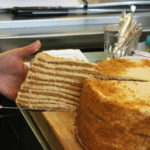

Sweet! Both the torte and the book. The torte because, well, Sacher Torte. The book because it sounds like an excellent resource. Such a nice post — thanks.
I give you a lot of credit for baking the Sacher torte, especially as the recipe sounds more complicated than the original. Great job!
Hi Karen: It’s actually not that intimidating if you think of it as just a little more involved than a regular two-layer, frosted cake. AT least, that’s what I kept telling myself until I finished it. LOL
Pingback: 26 Authentic German Desserts – The Kitchen Community